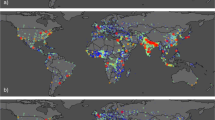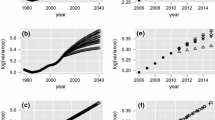Abstract
This paper argues that imperfect data should not hinder the search for alternative projection models and methods. Given the available data on urbanization, autoregressive projection models should be preferred to explanatory models for projections though explanatory models are more suitable for analyzing past trends. Alternatives to the UN’s projection method, Bayesian projection included, should account for the social and economic inequalities embedded in the global, national and sub-national urban systems.



Similar content being viewed by others
Notes
The World Urbanization Prospects database (http://esa.un.org/unpd/wup/) refers to the publicly available estimates and projections for urban and rural, population and cities for locations greater than 750,000 persons, as described by Buettner in this volume.
WUP2011 data source Urban Population, China: up to 1982: total population of cities and towns. Cities had to have a population of at least 100,000 or command special administrative, strategic, or economic importance to qualify as cities. Towns were either settlements with more than 3000 inhabitants of whom more than 70 % were registered as non-agricultural or settlements with a population ranging from 2500 to 3000 inhabitants of whom more than 85 % were registered as non-agricultural. For the 1990 census, the urban population included: (1) all residents of urban districts in provincial and prefectural-level cities; (2) resident population of "streets" (jiedao) in county-level cities; (3) population of all residents' committees in towns. For the 2000 census, the urban population was composed of population in City Districts with an average population density of at least 1500 persons per square kilometer, other population in suburban-district units and township-level units meeting criteria such as "contiguous built-up area," being the location of the local government, or being a Street or having a Resident Committee. For the 2010 census, urban population included all urban residents meeting the criterion defined by the National Bureau of Statistics of China in 2008, i.e., the criterion used in the 2000 census plus residents living in villages or towns in outer urban and suburban areas that are directly connected to municipal infrastructure, and that receive public services from urban municipalities (Downloaded 19 June 2013).
References
Alkema, L., Raftery, A. E., Gerland, P., Clark, S. J., Pelletier, F., Buettner, T., & Heilig, G. K. (2011). Probabilistic projections of the total fertility rate for all countries. Demography, 48(3), 815–839. doi:10.1007/s13524-011-0040-5.
Balk, D., Montgomery, M. R., McGranahan, G., Kim, D., Mara, V., Todd, M., Buettner, T., & Dorélien, A. (2009). Mapping urban settlements and the risks of climate change in Africa, Asia and South America. Population Dynamics and Climate Change, 80.
Bocquier, P. (2003). L’importance relative de la fuite des cerveaux : la place de l’Afrique sub-saharienne dans le monde. In R. par Barré, V. Hernandez, J.-B. Meyer, & D. Vinck (Eds.), Diasporas scientifiques - Scientific Diasporas (pp. 160–177). Paris: IRD Editions.
Bocquier, P. (2005). World urbanization prospects: An alternative to the UN model of projection compatible with urban transition theory. Demographic Research, 12(9), 197–236.
Bocquier, P., & Mukandila, A. (2011). African urbanization trends and prospects. African Population Studies, 25(2), 337–361. (25th year commemorative edition).
Bocquier, P., & Traoré, S. (2000). Urbanisation et dynamique migratoire en Afrique de l’Ouest - La croissance urbaine en panne (p. 148). Paris: L’Harmattan.
Chase-Dunn, C. (1998). Global formation. Structures of the world-economy. Updated edition. Lanham, MD: Rowman & Littlefield.
Chen, N., Valente, P., & Zlotnik, H. (1998). What do we know about recent trends in urbanization? In R. Bilsborrow (Ed.), Migration, urbanization and development, new directions and issues. Dordrecht: UN Population Fund and Kluwer.
Chi, G. (2009). Can knowledge improve population forecasts at subcounty levels? Demography, 46(2), 405–427.
Cohen, B. (2004). Urban growth in developing countries: A review of current trends and a caution regarding existing forecasts. World Development, 32(1), 23–51.
Cohen, J., Roig, M., Reuman, D., & Gogwilt, Cai. (2008). International migration beyond gravity: A statistical model for use in population projections. Proceedings of the National Academy of Sciences, 105(40), 15269–15274.
Courgeau, D. (1988) Méthodes de mesure de la mobilité spatiale. Editions de l’Institut National des Etudes Démographiques.
Davis, J. C., & Henderson, J. V. (2003). Evidence on the political economy of the urbanization process. Journal of Urban Economics, 53, 98–125.
Dyson, T. (2011). The role of the demographic transition in the process of urbanization. Population and Development Review, 37, 34–54.
Fox, S. (2012). Urbanization as a global historical process: Theory and evidence from sub-Saharan Africa. Population and Development Review, 38(2), 285–310.
Henderson, J. V. (2003). The urbanization process and economic growth: The so-what question. Journal of Economic Growth, 8(1), 47–71.
Hugo, G., & Champion, A. (2003). New forms of urbanisation. Aldershot: Ashgate.
Jones, B., & O’Neill, B. C. (2013). Historically grounded spatial population projections for the continental United States. Environmental Research Letters, 8(4), 044021.
Keyfitz, N. (1982). Can knowledge improve forecasts? Population and Development Review, 8, 729–751.
Lutz, W., & Goldstein, J. R. (2004). Introduction: How to deal with uncertainty in population forecasting? International Statistical Review, 72(1), 1–4.
Lutz, W., Sanderson, W. C., & Scherbov, S. (Eds.). (2004). The end of world population growth in the 21st century new challenges for human capital formation and sustainable development. London: Earthscan.
National Research Council (Ed.). (2003). Cities transformed—demographic change and its implications in the developing world. Washington, DC: The National Academies Press.
O’Neill, B. C., Balk, D., Brickman, M., & Ezra, M. (2001). A guide to global population projections. Demographic Research, 4(8), 203–288.
O’Neill, B. C., & Scherbov, S. (2006). Interpreting UN urbanization projections using a multi-state model (p. 21). Laxenburg: IIASA.
Raftery, A. E., Alkema, L., & Gerland, P. (2014). Bayesian population projections for the United Nations. Statistical Science, 29(1), 58–68.
Raftery, A., Chunn, J., Gerland, P., & Ševčíková, H. (2013). Bayesian probabilistic projections of life expectancy for all countries. Demography, 50(3), 777–801.
Raftery, A. E., Li, N., Ševčíková, H., Gerland, P., & Heilig, G. K. (2012). Bayesian probabilistic population projections for all countries. Proceedings of the National Academy of Sciences, 109(35), 13915–13921. doi:10.1073/pnas.1211452109.
Stillwell, J. (2005). Inter-regional migration modelling: A review and assessment. 45th Congress of the European Regional Science Association. Vrije Universiteit Amterdam, Amterdam, p. 26.
Tremblay, K. (2001). “Student mobility between and towards OECD countries: A comparative analysis”, in SOPEMI: Trends in international migration. Annual report, Paris (OCDE/OECD), pp. 93–117.
Zelinsky, W. (1971). The hypothesis of the mobility transition. The Geographical Review, 61(2), 219–249.
Author information
Authors and Affiliations
Corresponding author
Rights and permissions
About this article
Cite this article
Bocquier, P. The Future of Urban Projections: Suggested Improvements on the UN Method. Spat Demogr 3, 109–122 (2015). https://doi.org/10.1007/s40980-015-0005-1
Published:
Issue Date:
DOI: https://doi.org/10.1007/s40980-015-0005-1




